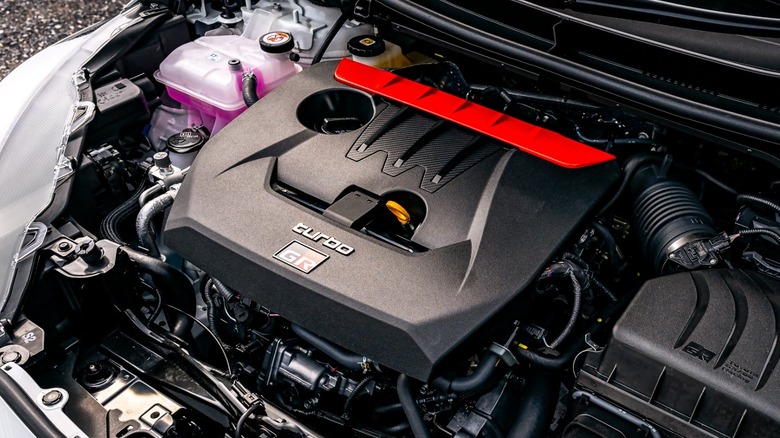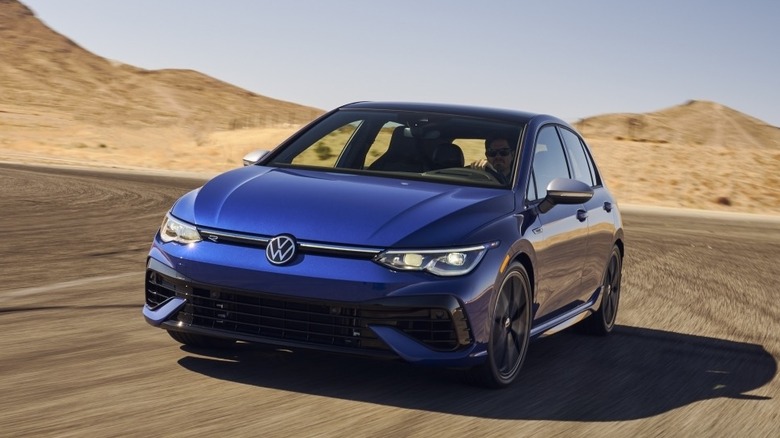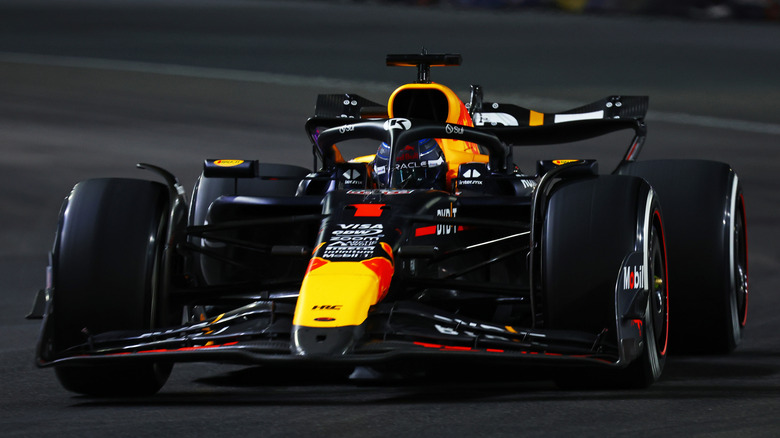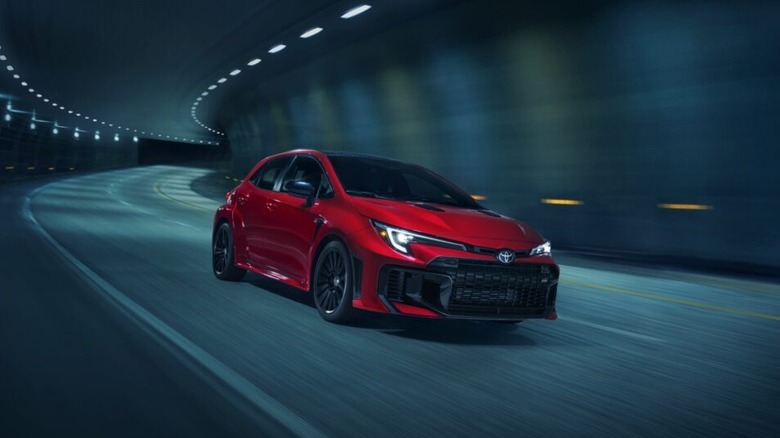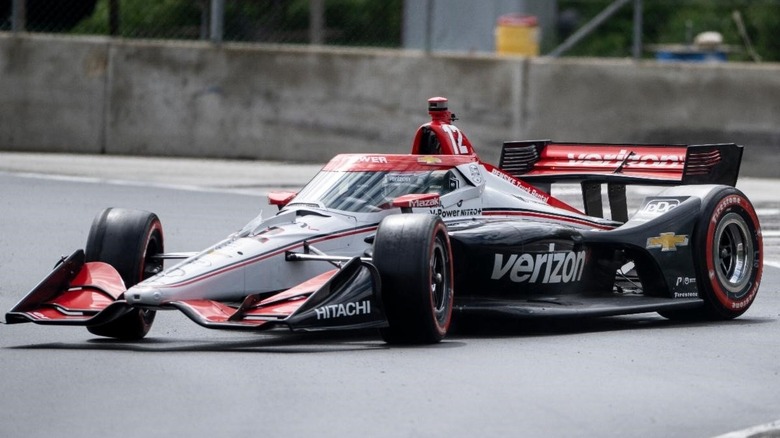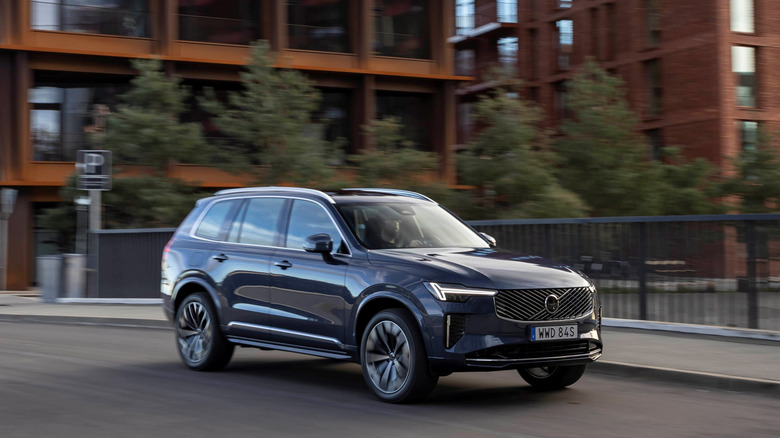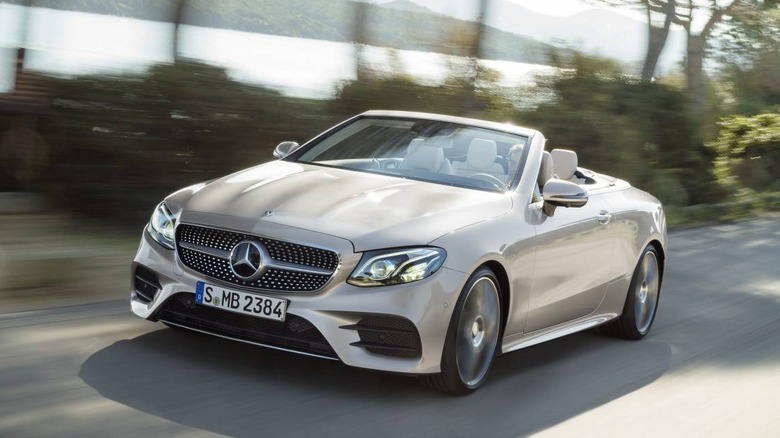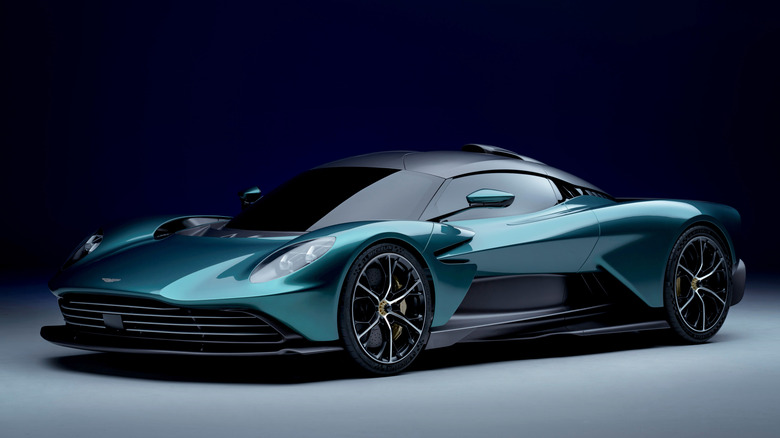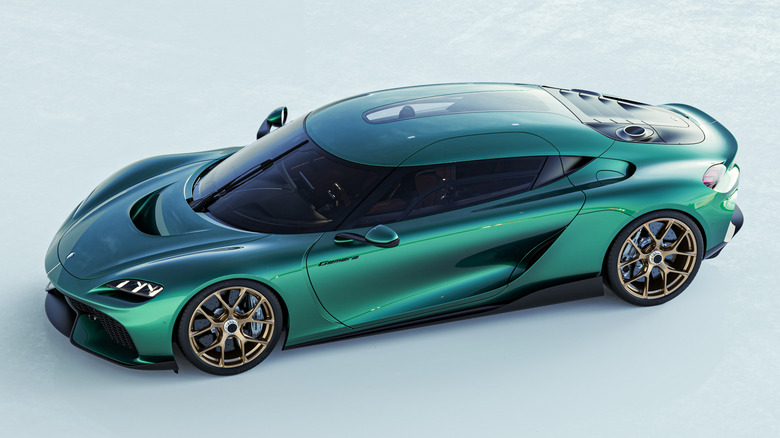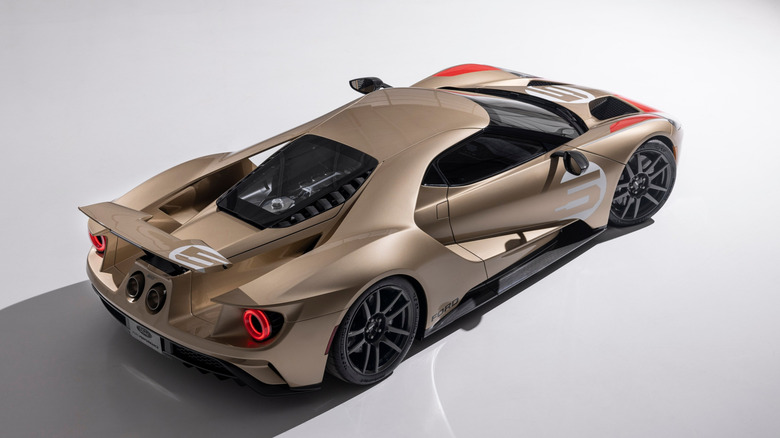10 Small Car Engines With Impressive Horsepower Output
When it comes to high-output engines, cars with lots of cylinders — like ones sporting a V10, V12, or even W16 engine — are probably the first thing to come to mind. These powerful engines include the likes of the Bugatti W16 engine, and even V8 Dodge crate engines. However, advancements in both design and technology mean that you no longer must rely on sheer displacement to deliver power. Forced induction has allowed engine manufacturers to get more power out of smaller engines, thus increasing efficiency.
The result of these innovations is more than just saving fuel, though: these small car engines also help cut down on size and weight, allowing engineers to put more horses in smaller, lighter vehicles. It's perhaps no surprise, then, that these engines can be found in a wide variety of models both on the road and on racetracks, including everything from hybrids and sports cars all the way to eye-catching hypercars and some of the fastest Formula 1 cars of all time.
Volkswagen EA888 Evo 4
The Volkswagen EA888 is quite a popular engine, after having been introduced in 2004 and added to many VW, SEAT, and Audi models. It's one of the most reliable VW engines ever made, but its performance Evo 4 version is the one that lands on the list of the most powerful inline-4 engines ever put in a car.
When Volkswagen installed this engine in VW Golf R we reviewed in 2022, the company was able to eke out 329 hp and 310 lb.-ft of torque from this two-liter inline-four engine. This means you get 164.5 hp for every liter this engine has. VW achieved this by adding a turbocharger to force more air into the engine. It also used a cast-iron block with an aluminum alloy cylinder head — a tried-and-tested formula for making dependable and high-performance engines.
Aside from the Golf R, you can also find detuned versions of the EA888 in other vehicles, like the Audi A3 and Volkswagen Tiguan. It's also available in a smaller 1.8-liter variant, powering more mundane Volkswagen group models, like Jetta, Passat, and Amarok.
Honda RBPTH002
Despite the howling cacophony that is the exhaust note of a modern Formula 1 car, the engine itself is quite small. The Honda RBPTH002 used by Oracle Red Bull Racing's team in its RB20 F1 car has a displacement of only 1.6 liters. The V6 weighs in at 330 pounds altogether, and has a redline of a positively screaming 15,000 rpm. Yet, despite its small size, it has a maximum output, according to Honda, of 900 horsepower. Working together with its hybrid electric motors, the little Honda can give the Red Bull car well over 1,000 horsepower when conditions allow. To put that into perspective, the 1.6-liter four-cylinder used in another iconic Honda, the sixth-generation Civic, only made 115 horsepower.
The Red Bull's Honda engine might be small, but it certainly isn't cheap. Red Bull notes that the engine, transmission, and chassis needed to actually deliver the power to the wheels clocks in at around $10.6 million. It's certainly not an engine you can just buy off eBay and throw in a muscle car for a day at the drag strip.
Toyota G16E-GTS
Toyota returned to the hot-hatch scene with its GR Yaris and GR Corolla models. The GR Yaris remains one of the models we wish we could get in the US, but at least we have the larger GR Corolla to play with. Both hot hatches are based on compact sedans or hatchbacks, so it makes sense for Toyota to use the smallest but most powerful engine it has: the G16E-GTS.
This engine has been tailor-made for the GR Yaris and was later adapted for the GR Corolla. But what makes the G16E more impressive is that it has the smallest displacement of all the engines we have in our list, at just 1.6 liters. This three-cylinder engine can output an astounding 300 hp and 273 lb.-ft of torque, meaning it delivers 187.5 hp/L.
Just like the rest of the engines in this list, the G16E uses a turbo to suck in more air and burn more fuel. At the same time, it uses two cooling jackets for the cylinder heads and a water-cooled oil cooler, allowing the engine to stay cooler for longer, and letting Toyota squeeze more horses out of it.
Chevy INDYCAR V6
In addition to making muscle car V8s and the power plant for any variety of wild Corvette, Chevrolet also makes engines for INDYCAR. One such engine is the twin-turbo V6 that has gained the maker a total of six Indy 500 wins. It has a displacement of only 2.2 liters. Racing on ethanol, it's capable of making a maximum of 700 horsepower. That power is boosted to 850 horsepower with the help of hybrid electric motors. Like the Formula 1 engine, its redline is similarly absolutely bonkers at 12,000 rpms.
That small engine size helps an IndyCar achieve an incredibly low weight. Without the driver, an average IndyCar weighs in at an impressive 1,785 pounds, or about half the weight of an average passenger car. Well over 800 horsepower and a low weight allow an IndyCar to reach a top speed of 240 miles per hour when going all out.
Volvo VEA B420
Volvo promised way back in 2011 that it would make smaller engines without performance cuts. More than 10 years later and we see that the Swedish car company has stood true to its word with the VEA B420. The B420 is a part of the VEA engine family, which started production in 2013. Although you can find the VEA engine in practically every Volvo car, the B420 is a special breed, as you can only find it in top-end Volvo models; specifically, the Volvo S90 and the Volvo XC90.
This 2-liter inline-four engine can output 320 hp and 295 lb.-ft of torque, giving it 200 hp per liter of displacement. Volvo achieved this by adding a turbocharger and a supercharger to the engine — the latter is used to deliver power immediately, while the turbocharger gives the engine its torque figures and more air at the higher end of the power band.
Ferrari Flat-12
Turning back the clock a full 50 years, Ferrari's efforts in Formula 1 produced some astonishingly small, yet incredibly complex, engines. One such engine was the power plant of choice for the 312 T, a car that propelled F1 legend Niki Lauda to a world championship. The 312 T itself is a wild looking car, with its relatively small size and towering intake above the cockpit. The engine itself is no less wild. A displacement of 3.0 liters isn't that small compared to some of the other engines on this list, but when you consider the fact that it's a flat-12, it becomes a little crazier.
Ferrari rated the engine at 495 horsepower at 12,200 rpms. This was long before the days of carbon fiber and high-tech computer aided design. The 3.0-liter flat-12 powered a race car steel-framed race car that only weighed 1,267 pounds. It might seem low-tech today, but in 1975, it was like piloting the Space Shuttle.
Daimler-Benz M139
Outside from the Mercedes-AMG ONE with its 1,063 hp hybrid engine, one of the fastest Mercedes-Benz cars you can get today isn't a supercar, grand tourer, or a coupe. Instead, it's a four-door sedan called the Mercedes-AMG GT 63. However, this is an expensive beast with a hybrid V8 heart that comes with a six-figure price tag.
If you want something more affordable, you could go for the identical looking Mercedes-Benz CLA AMG 45. But even if this car is cheaper than its bigger brother and comes with a smaller four-pot, don't be fooled — this 2-liter engine can deliver 416 hp and 369 lb.-ft of torque.
But if you want even more power from a four-cylinder engine, then you should look at the Mercedes-AMG GLC 63. The gasoline engine in this SUV puts out 469 hp and 402 lb.-ft of torque, meaning you can squeeze 234.5 horses for every liter that this engine has.
Mercedes-AMG V8
In 2014, Mercedes-AMG developed its now ubiquitous 4.0-liter BiTurbo V8. Back then, it managed to throw down 503 horsepower when it was first used for the AMG GT. Fast-forward more than a decade, and it's now the go-to engine for a large number of not only AMG cars, but Aston Martin as well. Under the hood of a hybrid Mercedes-AMG S 63 S, the 4.0-liter generates a beefy 791 horsepower. That allows a boat of a luxury car like the S-Class to achieve a 0-60 time of just 3.3 seconds, beating out some supercars.
With Aston Martin, the 4.0-liter is similarly monstrous, albeit with a more British flair. Aston Martin's 1,064 horsepower supercar, the Valhalla, uses a 4.0-liter V8 along with electric motors to reach a top speed of 217 miles per hour. It has a 0-60 time of 2.5 seconds. The AMG V8 might not be that big compared to other V8s, but its influence on the performance car world is undeniable.
Koenigsegg TFG twin-turbo
If you're an ultra-high net worth individual and want a hypercar, but also want to take your family with you when you drive, then you no longer have to pick between a two-door or a sedan — you can get the best of both worlds with the Koenigsegg Gemera, powered by Koenigsegg's own TFG, or "Tiny Friendly Giant," twin-turbo engine and three electric motors.
When combined, you get over 1,700 hp out of the Gemera, but what's more impressive is its gasoline engine. The TFG is just a 2-liter inline-three, but it can push out 592 hp and 443 lb.-ft of torque with the help of two turbos, delivering an eye-popping 296 hp/L. What's more impressive is that you don't have to limit yourself to high-performance fuels. Instead, you can put in Gen 2.0 ethanol, E85, or even other more eco-friendly fuels, and the engine will happily speed along.
When you combine this over 500 hp engine with the three electric motors on the Gemera, you get an absolute beast that can seat a family of four. And with its 3.5-second 0-60 mph record and top speed of 268 mph, you wouldn't believe that a small three-cylinder engine sits inside it to help its electric motors move along.
Ford EcoBoost V6
Typically, a Ford EcoBoost is not associated with insane amounts of power or speed. That's partly due to the fact that most people's experience with the EcoBoost begins and ends with something a little more pedestrian like a Ford Escape or F-150. At most, it's seen as the slightly spicy engine of the base model Mustang. However, that classification as a milquetoast engine couldn't be further from the truth.
Ford's own GT supercar uses a 3.5-liter EcoBoost V6. To be fair, this isn't an engine ripped right out of a Ford Explorer and thrown into a high-tech carbon fiber chassis. It's the result of an extensive amount of race-centric engineering. That results in an EcoBoost engine that made 647 horsepower and gave the GT a top speed of 216 miles per hour in 2017. The track-only Ford GT Mk IV puts out over 800 horsepower. Huge fire-breathing V8s are undoubtedly cool, but there's no replacement for scientific advancement.
